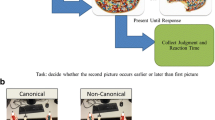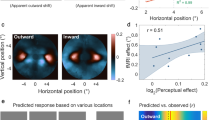Abstract
In this article, we review recent research studying the mechanisms for transforming coordinate systems to encode space, time and motion. A range of studies using functional imaging and psychophysical techniques reveals mechanisms in the human brain for encoding information in external rather than retinal coordinates. This reinforces the idea of a tight relationship between space and time, in the parietal cortex of primates.





Similar content being viewed by others
References
Alhazen I (1083) Book of optics. In: Sabra AI (ed) The optics of Ibn al-Haytham. Warburg Institute, London, 1989
Ben Hamed S, Duhamel JR, Bremmer F, Graf W (2002) Visual receptive field modulation in the lateral intraparietal area during attentive fixation and free gaze. Cereb Cortex 12(3):234–245
Binda P, Cicchini GM, Burr DC, Morrone MC (2009) Spatiotemporal distortions of visual perception at the time of saccades. J Neurosci 29(42):13147–13157
Bueti D, Walsh V (2009) The parietal cortex and the representation of time, space, number and other magnitudes. Philos Trans R Soc Lond B Biol Sci 364(1525):1831–1840
Bueti D, Bahrami B, Walsh V (2008) Sensory and association cortex in time perception. J Cogn Neurosci 20(6):1054–1062
Burr DC, Morrone MC, Ross J (2001) Separate visual representations for perception and action revealed by saccadic eye movements. Curr Biol 11(10):798–802
Burr D, Tozzi A, Morrone MC (2007) Neural mechanisms for timing visual events are spatially selective in real-world coordinates. Nat Neurosci 10(4):423–425
Cavanagh P, Hunt AR, Afraz A, Rolfs M (2010) Visual stability based on remapping of attention pointers. Trends Cogn Sci 14(4):147–153
Cicchini GM, Morrone MC (2009) Shifts in spatial attention affect the perceived duration of events. J Vis 9(1): 9.1–13
Cohen YE, Andersen RA (2002) A common reference frame for movement plans in the posterior parietal cortex. Nat Rev Neurosci 3(7):553–562
Crespi SA, Biagi L, Burr DC, d’Avossa G, Tosetti M, Morrone MC (2009) Spatial attention modulates the spatiotopicity of human MT complex. Perception, 38, ECVP Abstract Supplement
d’Avossa G, Tosetti M, Crespi S, Biagi L, Burr DC, Morrone MC (2007) Spatiotopic selectivity of BOLD responses to visual motion in human area MT. Nat Neurosci 10(2):249–255
Demeyer M, De Graef P, Wagemans J, Verfaillie K (2009) Transsaccadic identification of highly similar artificial shapes. J Vis 9(4): 28.1–14
Demeyer M, De Graef P, Wagemans J, Verfaillie K (2010) Parametric integration of visual form across saccades. Vision Res 50(13):1225–1234
Deubel H, Schneider WX (1996) Saccade target selection and object recognition: evidence for a common attentional mechanism. Vision Res 36(12):1827–1837
Duhamel JR, Colby CL, Goldberg ME (1992) The updating of the representation of visual space in parietal cortex by intended eye movements. Science 255(5040):90–92
Duhamel J, Bremmer F, BenHamed S, Graf W (1997) Spatial invariance of visual receptive fields in parietal cortex neurons. Nature 389:845–848
Durand JB, Trotter Y, Celebrini S (2010) Privileged processing of the straight-ahead direction in primate area V1. Neuron 66(1):126–137
Enns JT, Brehaut JC, Shore DI (1999) The duration of a brief event in the mind’s eye. J Gen Psychol 126(4):355–372
Galletti C, Battaglini PP, Fattori P (1993) Parietal neurons encoding spatial locations in craniotopic coordinates. Exp Brain Res 96:221–229
Gardner JL, Merriam EP, Movshon JA, Heeger DJ (2008) Maps of visual space in human occipital cortex are retinotopic, not spatiotopic. J Neurosci 28(15):3988–3999
Giora E, Morgan MJ, Solomon JA (2006) Parallel processing is much harder for temporal duration than for spatial length. J Vision 6:1012
Golomb JD, Chun MM, Mazer JA (2008) The native coordinate system of spatial attention is retinotopic. J Neurosci 28(42):10654–10662
Goossens J, Dukelow SP, Menon RS, Vilis T, van den Berg AV (2006) Representation of head-centric flow in the human motion complex. J Neurosci 26(21):5616–5627
Gottlieb JP, Kusunoki M, Goldberg ME (1998) The representation of visual salience in monkey parietal cortex. Nature 391(6666):481–484
Irwin DE, Yantis S, Jonides J (1983) Evidence against visual integration across saccadic eye movements. Percept Psychophys 34(1):49–57
Janssen P, Shadlen MN (2005) A representation of the hazard rate of elapsed time in macaque area LIP. Nat Neurosci 8(2):234–241
Johnston A, Arnold DH, Nishida S (2006) Spatially localized distortions of event time. Curr Biol 16(5):472–479
Jonides J, Irwin DE, Yantis S (1983) Failure to integrate information from successive fixations. Science 222(4620):188
Kanai R, Paffen CL, Hogendoorn H, Verstraten FA (2006) Time dilation in dynamic visual display. J Vis 6(12):1421–1430
Kaneko S, Murakami I (2009) Perceived duration of visual motion increases with speed. J Vis 9(7):14
Leon MI, Shadlen MN (2003) Representation of time by neurons in the posterior parietal cortex of the macaque. Neuron 38(2):317–327
Macknik SL, Martinez-Conde S (2004) Dichoptic visual masking reveals that early binocular neurons exhibit weak interocular suppression: implications for binocular vision and visual awareness. J Cogn Neurosci 16(6):1049–1059
McKyton A, Zohary E (2007) Beyond retinotopic mapping: the spatial representation of objects in the human lateral occipital complex. Cereb Cortex 17(5):1164–1172
Melcher D (2005) Spatiotopic transfer of visual-form adaptation across saccadic eye movements. Curr Biol 15(19):1745–1748
Melcher D, Morrone MC (2003) Spatiotopic temporal integration of visual motion across saccadic eye movements. Nat Neurosci 6(8):877–881
Morgan MJ (2003) The space between your ears: how the brain represents visual space. Weidenfeld & Nicolson, London
Morrone MC, Ma-Wyatt A, Ross J (2005a) Seeing and ballistic pointing at perisaccadic targets. J Vis 5(9):741–754
Morrone MC, Ross J, Burr D (2005b) Saccadic eye movements cause compression of time as well as space. Nat Neurosci 8(7):950–954
Ong WS, Bisley JW (2010) A study of peri-saccadic remapping in area MT. JoV, abstract (in press)
Ong WS, Hooshvar N, Zhang M, Bisley JW (2009) Psychophysical evidence for spatiotopic processing in area MT in a short-term memory for motion task. J Neurophysiol 102(4):2435–2440
Pouget A, Deneve S, Duhamel JR (2002) A computational perspective on the neural basis of multisensory spatial representations. Nat Rev Neurosci 3(9):741–747
Reeves A, Sperling G (1986) Attention gating in short-term visual memory. Psychol Rev 93(2):180–206
Rose D, Summers J (1995) Duration illusions in a train of visual stimuli. Perception 24(10):1177–1187
Sapir A, Hayes A, Henik A, Danziger S, Rafal R (2004) Parietal lobe lesions disrupt saccadic remapping of inhibitory location tagging. J Cogn Neurosci 16(4):503–509
Sereno MI, Huang RS (2006) A human parietal face area contains aligned head-centered visual and tactile maps. Nat Neurosci 9(10):1337–1343
Silver MA, Kastner S (2009) Topographic maps in human frontal and parietal cortex. Trends Cogn Sci 13(11):488–495
Snyder LH, Grieve KL, Brotchie P, Andersen RA (1998) Separate body- and world-referenced representations of visual space in parietal cortex. Nature 394(6696):887–891
Thompson P (1981) Velocity after-effects: the effects of adaptation to moving stimuli on the perception of subsequently seen moving stimuli. Vision Res 21(3):337–345
Thompson P, Burr D (2009) Visual after effects. Curr Biol 19(1):R11–R14
Treisman M (1963) Temporal discrimination and the indifference interval. Implications for a model of the “internal clock”. Psychol Monogr 77(13):1–31
Trotter Y, Celebrini S (1999) Gaze direction controls response gain in primary visual-cortex neurons. Nature 398(6724):239–242
Tse P, Intriligator J, Rivest J, Cavanagh P (2004) Attention and the subjective expansion of time. Percept Psychophys 66:1171–1189
Walsh V (2003) A theory of magnitude: common cortical metrics of time, space and quantity. Trends Cogn Sci 7(11):483–488
Wittenberg M, Bremmer F, Wachtler T (2008) Perceptual evidence for saccadic updating of color stimuli. J Vis 8(14): 9.1–9
Wohlgemuth A (1911) On the after effect of seen movement. Br J Psychol Monogr Suppl 1:1–117
Womelsdorf T, Anton-Erxleben K, Pieper F, Treue S (2006) Dynamic shifts of visual receptive fields in cortical area MT by spatial attention. Nat Neurosci 9(9):1156–1160
Wurtz RH (2008) Neuronal mechanisms of visual stability. Vision Res 48(20):2070–2089
Zipser D, Andersen RA (1988) A back-propagation programmed network that simulates response properties of a subset of posterior parietal neurons. Nature 331(6158):679–684
Acknowledgments
Supported by EEC framework 6 (MEMORY) and 7 (ERC: STANIB) and Italian Ministry of Universities and Research.
Author information
Authors and Affiliations
Corresponding author
Rights and permissions
About this article
Cite this article
Morrone, M.C., Cicchini, M. & Burr, D.C. Spatial maps for time and motion. Exp Brain Res 206, 121–128 (2010). https://doi.org/10.1007/s00221-010-2334-z
Received:
Accepted:
Published:
Issue Date:
DOI: https://doi.org/10.1007/s00221-010-2334-z




